Spine Injury in Golfers
The golf swing is a highly complex and a very dynamic and involved movement. The reason for the complexity is because it involves the entire body and all of its joints. The motion requires a balance of mobility and stability, as well as adequate motor control to be able to generate the right amount of power to meet the physical demand that is placed on the body. The spine alone is made up of 33 bony segments, and is designed to absorb and distribute external loads or forces that are placed on the body. When there is a dysfunction in spinal mobility, spinal stability, or motor control, then the spine is at risk for injury or exacerbation of existing injury. Low back injury in golf can either be caused by certain swing characteristics, or can be significantly worsened by these characteristics, if already existing.
Anatomy 101
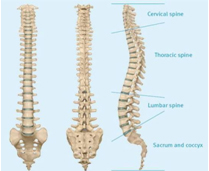 1
1
The spine is comprised of 33 bony segments called vertebrae: 7 cervical (neck), 12 thoracic (torso), 5 lumbar (low back), and the 5 remaining fused vertebrae comprise the sacrum with the coccyx (tailbone) at the end. Each region of the spine has a primary direction of movement. The cervical spine has the greatest rotary movement, the thoracic spine has the greatest side-to-side and rotary movement, and the lumbar spine is exclusively limited to bending straight forward and straight back. The spine has 4 curvatures to it: a forward curve in the cervical spine, a backward curve in the thoracic spine, a forward curve in the lumbar spine, and a backward curve in the sacrum. This S-shaped design is what helps the spine behave like a “spring,” absorbing shock. The spine is most vulnerable at the transition points of each curve, which is why low neck and low back injuries are the most common.
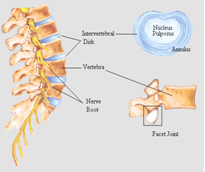 2
2
Intervertebral discs lie in between each vertebrae, and they form a cushion which also helps absorb shock. A gelatinous structure fills the center of this disc, and a heavily innervated fibrous elastic ring encapsulates the body. The discs are designed to provide flexible support and to help protect the spinal cord and nerve roots from injury. These structures, however have poor blood supply, so once injured, they only heal partially. Damage to these discs, either from acute injury, repetitive stress or strain, or normal aging, results in decreased spine shock absorption and ultimately pain.
Common Causes of Low Back Pain
There are several spine dysfunctions that cause low back pain. The most common include herniated discs, muscle strains, degenerative disc disease, and stenosis, amongst many other conditions. A herniated disc is the protrusion of the disc in between the vertebrae that may result in varying degrees of compression on the involved nerve root and subsequent varying levels of pain and/or numbness in the leg(s).
 3
3
Muscle strains can be a result of chronic overuse or over activation of a muscle or muscle group. Degenerative Disc Disease is a normal and common age-related arthritic thinning and hardening of the discs in between the vertebrae. One study indicated that “Diagnostic imaging findings consistent with lumbar disc degeneration are common and can be found in 34% of people between 20 and 39 years old, 59% of people between 40 and 59 years old, and 93% of people between 60 and 80 years old.” (Boden SD, 1990)4
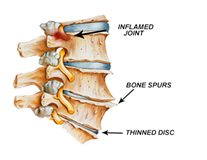 5
5
Finally, stenosis is the narrowing of the central and/or peripheral nerve canals of the vertebrae, caused by arthritic thickening of the bony surfaces. This can result in compression of the nerves, thereby causing pain and/or numbness in the lower extremity.
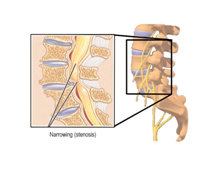 6
6
Golf Swing Characteristics Most Commonly Associated with LBP
As mentioned before, the golf swing is a complicated and a very involved mechanic. There are certain characteristics of the golf swing and address posture that are commonly associated with low back pain. Let’s discuss the golf address posture first. “S-Posture” is an address stance posture which is characterized by too much arch in the low back.
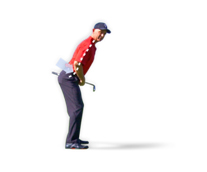 7
7
This places abnormally high stress on the muscles of the low back and results in the inhibition of the abdominal muscles, which can result in further strain and stress on the lumbar spine. According to a poll of about 400 amateur golfers, performed by researchers at the Titleist Performance Institute, 25.3% exhibited this characteristic at their golf address. Someone with a herniated or bulging disc will definitely be affected by the S-Posture because it place excessive pressure on the disc. Someone with degenerative disc disease or stenosis may also be affected by S-Posture, as the excessive extension of the spine, coupled with rotation, can create excessive torque and compression in the spine joints, which are already inflamed and compressed. The S-posture can also result in strains of the back muscles, as the abdominal muscles are inhibited and without their stabilization and support of the trunk, the back muscles take over and are overworked or pulled.
“C-Posture” is another address stance that is characterized by slumped or forward shoulders, as well as a distinct roundness to the back from the tailbone to the back of the neck.
 8
8
This posture is associated with significant limitation in thoracic extension and rotation, which ultimately inhibits the ability to have an adequate backswing, and therefore creates compensations and excessive spinal loading and torque. According to the TPI poll of amateur golfers, 33.1% had this posture at address. Someone with a herniated or bulging disc, may also be affected, as the excessive rounding of the spine may cause further protrusion of the disc, and coupled with rotation during the backswing, the disc can be significantly compressed, along with the nerve root. Someone with degenerative disc disease or stenosis is also affected by C-Posture, as the spine is inherently limited in rotation. Being further limited in thoracic spine rotation, they are going to have excessive loading throughout the lumbar spine, which is already being affected by narrowed disc and joint space. Finally having limited available rotational mobility, the back muscles may be strained trying to create more rotation during the backswing, resulting in a pulled muscle, or an overuse injury.
The leading swing characteristic that is responsible for low back pain is “Reverse Spine Angle.”
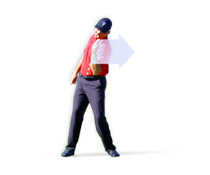 9
9
This is characterized by excessive upper body backward bending during the backswing, which makes it difficult for the pelvis to then initiate the downswing in the proper sequence; upper body tends to dominate the swing, and the lower body is inhibited from initiating the downswing, resulting in flight path problems and limited power output. The abdominal musculature is inhibited from the backswing position, and the lumbar spine joints are severely compressed. According to the TPI study, 38.5% of amateur golfers exhibited this characteristic. There is significant torque and pressure on a herniated or bulging disc due to the extension and side bending compression on the joints. These joints in the lumbar spine aren’t designed to rotate or side bend. The joint narrowing and bone thickening associated with degenerative disc disease or stenosis can be significantly affected by this swing pattern, again, excessive backward bending of the spine coupled with rotation, results in narrowing or compression of the joint space that is already compromised. Finally, low back muscles can be repeatedly strained with this characteristic, as one side is repeatedly overstretched, while the abdominal musculature is placed at a disadvantage and therefore works extra hard to stabilize.
Conclusion
In conclusion, low back injury in golf can either be caused by certain swing characteristics, or can be significantly worsened by these characteristics, if already existing. The spine is designed to be a highly resilient shock-absorbing structure, but when placed under repeated excessive biomechanical loads, or when the inherent stabilizing structures are compromised, the spine is at risk for injury, or exacerbation to an existing pathology. The golf swing is a highly complex and powerful motion. In order for the spine to adequately sustain the load placed upon it during the swing, it requires a balance of spinal mobility and stability, as well as adequate motor control to be able to generate the right amount of power to meet the physical demand that is placed on the body. If you are playing golf and you do have an existing known spinal injury, and play through the pain, it is likely that the pain will only continue to worsen, especially as your body tries to develop compensations which result in further inefficiencies of your mechanics. It is wise to consult with a healthcare provider who is trained and experienced in assessing and evaluating functional movement patterns that may either put you at risk for injury or are exacerbating an existing injury. Upon identifying certain faulty movement patterns, the appropriate provider can subsequently identify whether there are mobility dysfunctions vs stability/motor control dysfunctions, or both, and can therefore be specifically addressed. The ultimate goal is to be able to identify risk factors that may result in injury and to be educated on how to fix these impairments so that you can continue to play golf without injury and re-injury, and more importantly, maximize your golf potential.
1 “Spinal Anatomy.” Stourbridge Low Back Pain Relief. Web. 31 July 2014. < http://stourbridge-low-back-pain-relief.co.uk>
2 “Lumbar Spine Anatomy.” Family Practice Notebook. Web. 31 July 2014.
4 Boden SD, Davis DO, Dina ST, et al. Abnormal magnetic-resonance scans of the lumbar spine in asymptomatic subjects. J Bone Joint Surg Am 1990;72:403–408
5 “Spines.” Spine Surgery Clinic. Web. 31 July 2014.
6 “Spinal Stenosis.” University Neurosurgery. Web. 31 July 2014.
7 “S-Posture.” Titleist Performance Institute. Web. 31 July 2014.
8 “C-Posture.” Titleist Performance Institute. Web. 31 July 2014.
9 “Reverse Spine Angle.” Titleist Performance Institute. Web. 31 July 2014.
NOV

About the Author: